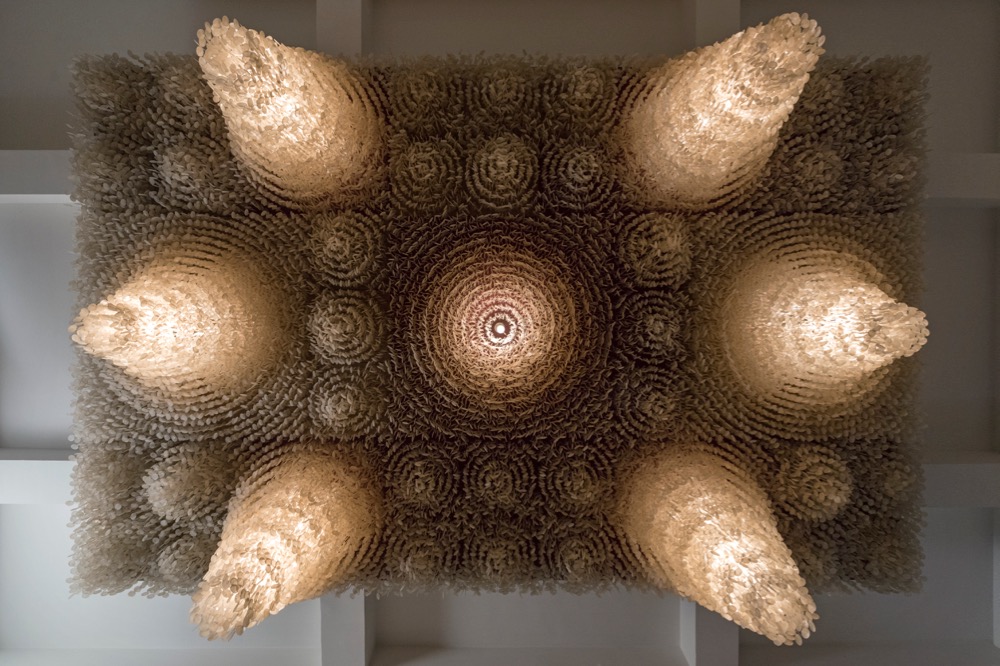An amazing Verner Panton lighting feature originally designed for Panton's own home in Hasenrainstrasse in Benningen Switzerland is now on semi permanent loan to the Kunsthalle museum in Basel with the support of Marianne and Carin Panton and Ameropa AG. The light feature was created over a period from 1972-1987 - first for Panton's house in Benningen and then later for a larger space in the family's apartment in Rebgasse, Basel. Made from hundreds of thousands of approximately 50mm discs of mother of pearl shell, the light feature is highly geometric but at the same time beautifully organic. The range of colours in the shells - purely because of the position of the light - is quite astounding.
A corner room on the Kunsthalle museum’s ground floor, adjacent and connected to the restaurant area, was chosen as the location for the light's installation and will be part of the restaurant but also utilized for special events. Christine Binswanger, a senior partner of Herzog & de Meuron and former member of the Kunstverein commission, met Marianne Panton, the widow Verner Panton, about ten years ago while working on an unrelated architectural project and was introduced to the possibility of a public revival of the light. In storage for thirty years, the light required careful restoration and sensitive placement by the museum's regular architects; Sauter von Moos.
What proved particularly challenging was that only one vague sketch for the hanging of the lamp existed. Since individual segments from different ages were being brought together, but not all were directly related to the sketch, with slight adaptations/improvisations needing to be made during the installation. The 50 segments of the original lamp were ‘stretched’ apart so as to cover the entire ceiling area of its new home in the museum more successfully. The ceiling installation (to call it a light sounds far too feeble for such an all encompassing feature) was based around the key concepts of the Fun series of lights designed by Panton in 1964 and produced by J. Lüber AG. While these lights started out as discs of aluminium foil lovingly cut by hand by Marianne Panton, they went into production as perfectly circular chromed discs and later in the much more organic form of natural shells. Many years of effort by the Basler Kunstverein has resulted in the restoration and fitting of the light into the former 'Weinstube' of Restaurant Kunsthalle. Panton was a Basel resident and regular guest of the restaurant back in the 80's so it is a very appropriate final resting place for the work.
The installation of the lighting feature precisely follows its original form with the room being redesigned by Sauter von Moos to maximise the light's effect. As befits the work of Verner Panton, Charlotte von Moos and Florian Sauter embraced Panton's obsession with circles and curves by designing rounded banquette seating and multiple round dining tables. When viewed in plan the dining room's layout compliments the shapes of the light overhead. The lighting fixture itself is enormous and falls approximately 2m from the ceiling. Consisting of seven Stalactite style inverted cone shapes, the pearlescent beauty of the shells is hard to describe. The architects have ensured the light remains the feature of the space by choosing softly curved chairs (the Saarinen Executive chair with wooden legs) in muted shades of dusty rose pink and mint velvet. A dark band of wall paneling keeps the furniture grounded so the light is given in its own pale grey space.
Shown above left is Verner Panton and wife Marianne in their home in Binningen Switzerland circa 1970-72. The photograph on the right shows the same room in the 80's with colour replaced by bold monochromatic elements.
Under the guidance of Mrs. Panton and Peter Frandsen, the CEO of VERPAN, a number of the fine metal cords and shells were repaired during the lamp’s hanging with students of architecture from ETH Zurich and industrial design of Fachhochschule Nordwestschweiz (FHNW) helping to document the parts and put the light together.
The original lights that inspired the Panton Stube lighting feature were manufactured by J. Lüber AG from 1964. Many of these designs have been reissued by Danish brand Verpan - with sixteen models being available across table, floor and pendant varieties. You can see the range here.
Sauter von Moos was established in Basel in 2010 by Florian Sauter and Charlotte von Moos. The studio engages in work on all scales, both in theory and practice and from domestic to public. Both graduates of architecture from ETH Zurich, Charlotte von Moos had previously collaborated with Herzog & de Meuron and was in charge of the VitraHaus in Weil am Rhein. Prior to co-founding Sauter von Moos, Florian Sauter worked with Christian Kerez on a series of competitions such as the Leutschenbach School and the Museum of Modern Art in Warsaw. Between 2006 and 2014 he co-edited the Architectural Papers at the Chair of Josep Lluis Mateo at ETH Zurich, and in 2011 acted as academic advisor for the retrospective Louis Kahn: The Power of Architecture.
"We like places of authenticity. Fine tuned environmental, urban and programmatic differentiation enhances spatial identity. We value a building's expressive powers, but also its need to answer the subtleties of the pragmatic. Fostering social exchange and interaction, our architecture should respond to both a communal and human scale. In each project, a specific assembly of rooms aims to create discrete backgrounds for life. Shaped by earth, water, air and light, our buildings seek to architecturalize nature. With the ease of a ruin we hope to bring the world to presence."
Sauter von Moos
The next post on Design daily will be a preview of Milan Design Week 2018 (April 17 -22).













